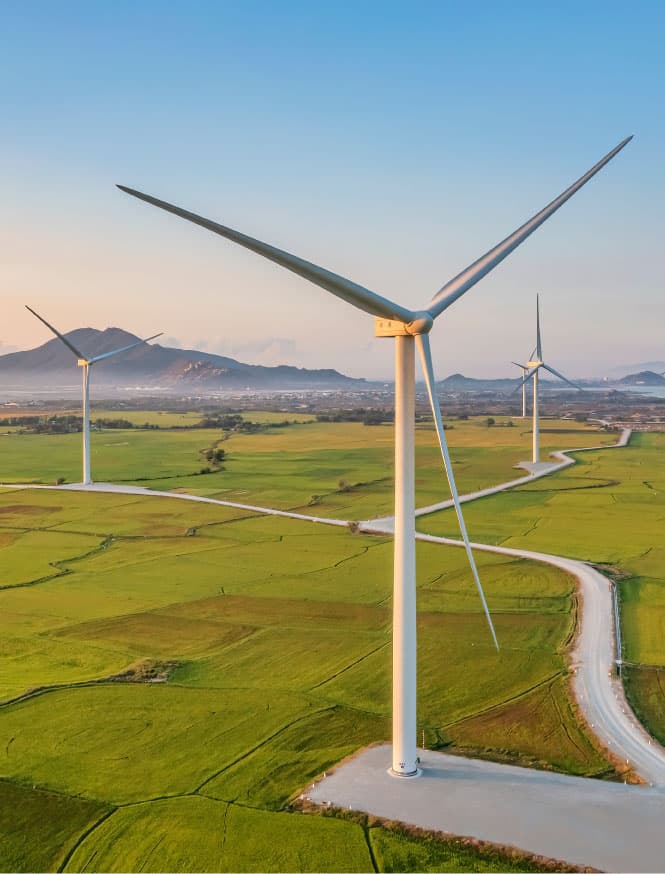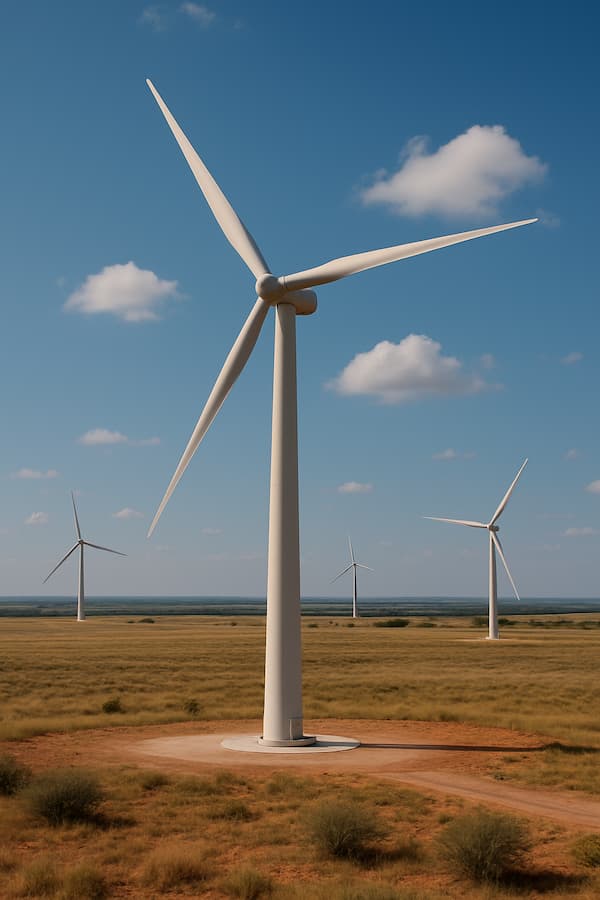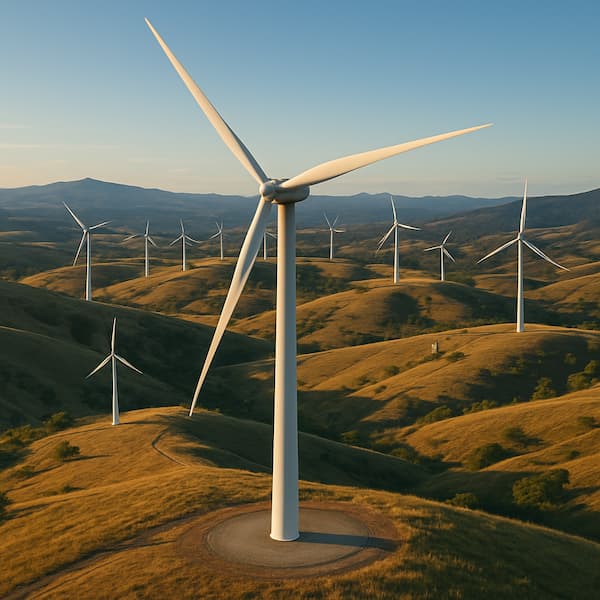Sell Your Wind Rights
Learn about wind energy rights, easements, leases, royalties, and accommodation agreements – including long-term risks, valuations, and the sale process.
Sell Your Wind Royalties (Request an Offer):
What Really Matters
How Wind Energy Rights Are Valued
There are many factors that play into the value of wind farm leases, easements, royalties, and other compensation. These include location, capacity, average wind speed, current royalty percentage, wind production, lease terms, and even the operator of the wind farm or project.
Location
Wind farms are typcially situated in areas with consistently high wind speeds, ideal terrain, and close proximity to electric transmission lines.
Capacity
Newer wind turbines are typcially rated for a higher capacity and generate more wind power and revenue.
Wind Speed
Higher average wind speeds genrate more wind energy and therefore, more revenue.
Production
Higher producing wind turbines generate more wind power over the life of the wind farm.
Lease Terms
Favorable lease terms positively impact the market value of wind royalties.
Operator
Large, experienced wind farm operators are often more financially sound.

The Bottom Line
How Much Are Wind Energy Payments Worth?
Wind energy development is still relatively new and has gained popularity over the last few decades, only to become unpopular again.
2018-2021: Green-Premium Era
Wind energy leases, easements, royalties, and other types of payments were highly sought after by fund managers who wanted renewables in their portfolio. These income-producing assets were not tied to oil and gas, making them ideal for investors and organizations divesting from fossil fuels.
Because of the high competition, fund managers were willing to pay a premium (6-9 years) – it was more about having renewables in the portfolio than the actual returns.
2020-2024 Market Challenges
Oil prices dropped during the pandemic, then soared again during the initial years of the Russia-Ukraine war, allowing for better returns in well-timed oil and gas investments, igniting a renewed interest.
Supply chain congestion and turbine quality problems plagued the industry, making it more costly to build and operate wind energy projects.
Prices for landowner wind leases, royalties, easements, and other accommodation agreement payments dropped to 3-5 years.
2024 – 2025: The Rise of AI & Changing Political Climate
The rise of AI, which is energy-intensive, has brought natural gas back into favor. After the 2024 election, political sentiments favored oil and gas, while disincentivizing renewables.
The Big Beautiful Bill (OBBA) removed vital tax incentives for wind energy development, and on July 21, 2025, Trump effectively halted all energy permits, both federal and private. This is devastating the wind energy sector.
Now, wind energy leases, easements, and other payments are viewed as highly risky, which has lowered the value to 2-5 years of cash flow, depending on a variety of factors.
Wind nucense and participation payments, with higher risk profiles (especially with no obligation to continue paying), may sell for even less.
The value of your wind royalties (and other participation or accommodation payments) greatly depends on a variety of factors, including the annual revenue, escalation clause, inflation adjustments, age of equipment, risk profile, and market conditions.
Weighing Risks and Benefits
Risks Associated with Wind Royalties & Payments
Unlike oil and gas royalties, which deplete over time, wind leases, easements, royalties and other accommodation payments often escalate over time. So, why would a landowner sell the royalties (or participation/accommodation agreements)? There are several significant risks associated with wind royalties.
Repowering
The biggest risk is a partial or full repowering. Wind turbines are mechanical and often need to be repowered after 8-13 years. As of 2025, wind energy permits have been halted, which impacts the ability to repower existing projects.
Inflation
Many wind easements, royalties, and accommodation agreements fail to account for inflation (or cap inflation), making the payments less valuable over time.
Wake Effects
Additional nearby wind development may introduce wake effects, reducing turbine production and potentially causing it to be moved or removed.
Contract Terms
Wind agreements usually favor the developer/operator and can often be canceled by the operator at any time. Future revenue may not be guaranteed, even if the wind project remains operational.
Greenfield Development
Incentives, such as Investment Tax Credits (eliminated by the Big Beautiful Bill) and county tax abatements, incentivize new development in a “greenfield” rather than repowering or extending the current lease agreement.
Political Climate
The political climate can encourage or discourage wind development. The Big Beautiful Bill eliminated tax incentives for reneables and Trump halted the permitting of wind energy permits in July of 2025, which impacts new projects and older projects in need of repowering (after about 9-13 years).
Modernization Moves
Full or Partial Repowering of Wind Projects
The biggest risk associated with owning wind royalties is a partial or full repowering of the wind farm. Wind turbines are known to have a useful life of 10-25 years, so most wind agreements have a primary term of 20-30 years.
However, the reality is that wind turbines are mechanical and need regular maintenance and part replacement. In just 9-13 years, most wind turbines need their blades and electronics replaced.
Side Note: Check out this Texas Monthly article about wind farm graveyards.
Wind turbine technology is rapidly evolving, and costs are dropping. Executives are often faced with the choice of replacing components vs. repowering, both of which are similar in cost.
Partial Repowering
Partial Repowering involves replacing key components, usually resulting in longer blades and newer technology installed in the original tower base. The wind project usually generates the same power capacity but uses fewer turbines (often half as many). The changes of your turbine being removed are fairly high, especially if you only receive royalties on one or two turbines. You could lose your win royalties entirely.
Full Repowering
The wind farm will be completely dismantled in a full repowering, and replacement turbines will be installed, often reusing roads, power lines, and substations. The new turbines will have a much larger rated capacity, but the wind farm will probably generate the same wind power output. In this situation, there is a real possibility that your turbine or turbines will be reduced or removed entirely.
Something else to consider: If you own wind royalties but not the surface, you may be more likely to lose your wind turbine(s) in a repowering event. Operators prefer the simplicity of dealing with royalty owners who also own the surface.

Downwind & Turbulence
Wind Wake Effects
As wind power development accelerates, new wind farms are being built near current wind farms, introducing the conflict of wind wake effects. If a new wind project places turbines upwind of your turbines, they could dramatically decrease the wind power generated. This is a huge issue in the legal world and one that has not yet been resolved in the courts.
Duke University’s Environmental Law and Policy Journal has an excellent publication called Wind Wakes, Wake Effect Impacts, and Wind Leases: Using Solar Access Laws as the Model for Capitalizing on Wind Rights during the Evolution of Wind Policy Standards, which is worth reading.


Evolving Wind Energy Law
Contract Terms & Future of Wind Development
The oil and gas industry has a robust body of law, but the wind energy industry is new and still developing. The legislation and case law are still being developed, so wind energy agreements and contracts are long and vary widely in content.
Typically, contracts have a primary term of 20-30 years with one or two 10-30 year extensions. Most property owners assume they will receive royalties or participation payments for up to 60 (or more) years. This may not be the case.
Wind projects are depowered, reducing the number of turbines but keeping power output the same. Other projects will be decommissioned. The wind industry is still new and developing. Technology will change, and new ways of harnessing clean and renewable energy will be developed.
Although wind farm popularity changes with the political climate, the reality is that we cannot fill our energy needs with wind and solar power. We have to develop a new solution, and it will probably be something that does not exist today. Wind is not a long-term solution.
Additionally, building wind turbines requires an enormous amount of fossil fuel-derived energy, and decommissioning results in a massive amount of waste.
The bottom line is that we don’t know what wind energy will look like in 20-60 years.
Additional Risks for Those Receiving Participation Payments
Landowners who receive participation payments, but do not host turbines normally have a contract clause stating the contract can be terminated by the operator at any time – it can be fully voluntary!
Selling Wind Royalties
Our Three-Step Process
Selling your wind royalties is easy. Request an offer, send your documents and we’ll do our due diligence and get back to you with an offer. If you choose to move forward, we’ll prepare the closing documents and walk you through the remote closing process.
1. Request an Offer
The first step in selling your wind royalties is to contact us. We’ll ask for your documents (lease, easement, agreements) and get back to you with an offer.
2. Review & Accept Offer
Please take some time to consider the offer – it’s a bit decision! If you would like to proceed, we will prepare the closing documents. We can usually close in days to weeks.
3. Closing Process
We’ll walk you through the remote closing process, which involves you notarizing a new agreement and receiving the wire transfer.
Sell Your Wind Royalties Rights (Request an Offer):
Unlock You Future Value
Sell Your Wind Royalties
(Or other Wind Compensation or Accommodation Payments)
Wind royalties used to demand a premium of 6-9 years’ cash flow, but the market has since cooled. An offer of 3-6 years is much more common now.
Whether you are closer to 3 years or 6 depends on a variety of factors, including the annual revenue, lease terms, esclation clauses, age of wind turbines, risks, and more.
What is a Wind Estate?
The wind estate refers to the intangible interest in the wind energy rights over a tract of land.
The concept is similar to mineral rights, but theoretically, the wind estate would give the owner the exclusive right to capture and monetize wind energy on or above the surface.
As of 2025, no state specifically allows for severing wind rights from the surface, but several states have anti-severance laws and statutes.
What’s the difference between an annual royalty payment and a nuisance (accommodation) payment?
There are two basic types of wind payments: royalties and compensation/accommodation payments.
Wind Royalties
Wind royalties are annual or semi-annual payments based on a flat rate and/or energy produced and sold by the wind turbines on your property.
Nuisance or Accommodation Payments
Nuisance or accommodation payments are paid to nearby landowners to compensate for the inconvenience of living near turbines (shadow flicker, noise, etc). They might also be paid to landowners or developers to avoid building turbines that might interfere with the wind turbines.
There are many different types of Nuisance, compensation, and accommodation payments. Some are tied to the lifespan of a particular wind project, and others can be canceled at any time, without penalty.
Can I sell my wind royalties separately from the underlying wind estate?
Yes, wind royalties, easements, and accommodation payments are often conveyed without transferring the underlying land-use rights. In fact, many states do not allow the severance of wind rights from the surface.
How long do typical wind agreements run?
Most wind agreements, similar to oil and gas leases, contain both a primary term and an optional extension.
Primary Term
The primary term often ranges from 15-20 years for smaller or community-scale projects and 20-30 years for utility-scale projects.
Extension Options
There are often automatic or optional extensions that can allow the project to continue beyond the primary term.
Note: Just because the project’s primary term is 15-30 years, it does not mean the project will continue for the full primary term. Turbines need to be depowered after 10-12 years, introducing significant risks.
Optional Extension
